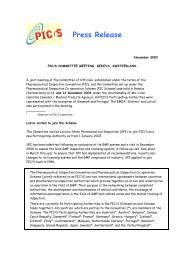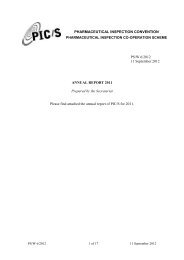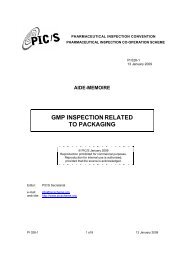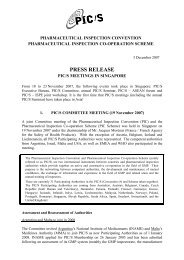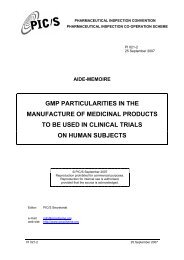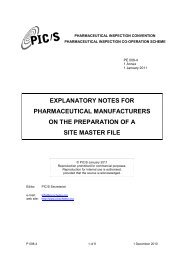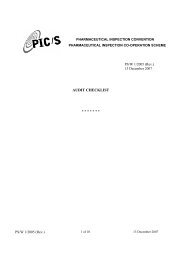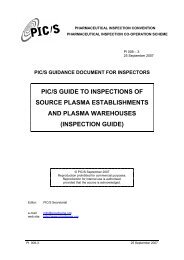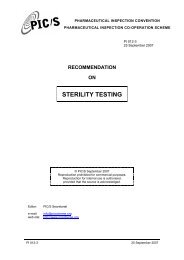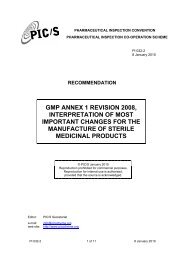Download - PIC/S
Download - PIC/S
Download - PIC/S
- No tags were found...
You also want an ePaper? Increase the reach of your titles
YUMPU automatically turns print PDFs into web optimized ePapers that Google loves.
ANNUAL REPORT 2008New Members1. On 1 January 2008, the National Institute of Medicaments (INAME) ofArgentina and the Medicines Authority of Malta (MAM) became the 32 nd and 33 rdParticipating Authorities of <strong>PIC</strong>/S, respectively.2. On 1 July 2008 Cyprus’ Pharmaceutical Services (CyPHS) joined <strong>PIC</strong>/S as the34 th Participating Authority. On 11 November 2009, the <strong>PIC</strong>/S Committee invitedFrance’s Veterinary Agency (ANMV) and Israel’s Institute for Standardization andControl of Pharmaceuticals (ISCP) to join <strong>PIC</strong>/S as the 35 th and 36 th ParticipatingAuthorities, but only as of 1 January 2009.Pharmaceutical Inspection Co-operation SchemeThe Pharmaceutical Inspection Co-operation Scheme (<strong>PIC</strong> Scheme) is an informal andflexible arrangement between GMP inspectorates. It entered into force in November1995. It is run in parallel with the Pharmaceutical Inspection Convention (seeAnnex II). The common logo for both is <strong>PIC</strong>/S.The Scheme retains and improves the Convention’s main features, i.e. the networkingand confidence building between the national inspection authorities, the development ofquality systems, the training of inspectors and other related experts and its work towardsglobal harmonisation of GMP. It is open to the participation of the inspectorates ofother countries.The main decision-making body is the <strong>PIC</strong>/S Committee in which all Members arerepresented and which meets at least once a year. The Committee is assisted in its taskby an Executive Bureau and a Secretariat.The <strong>PIC</strong>/S Executive Bureau’s task is to prepare meetings of the Committee, implementthe latter’s decisions and recommendations, monitor the Scheme’s activities and preparethe annual budget. The Bureau is composed of the Chairperson, two Deputies as well astwo Members of the Committee.Operation of the Scheme3. The <strong>PIC</strong>/S Committee, the <strong>PIC</strong>/S Executive Bureau and the <strong>PIC</strong>/S WorkingGroup on the Training of Inspectors met twice in the course of 2008.4. The <strong>PIC</strong>/S Committee met under the chairmanship of Mr. Jacques Morénas(France / French Health Products Safety Agency) first in Krakow (Poland) on 26-27 May 2008 and then in Geneva (Switzerland) on 11-12 November 2008.Annual Report 2008 1 of 11
5. During these meetings, the Committee initiated a consultation of ParticipatingAuthorities on the operation and the structure of <strong>PIC</strong>/S. A majority of PAs was satisfiedwith the current system. The Committee nominated a Working Group in charge ofmaking proposals on the way to further improve the current system based onsuggestions made by Participating Authorities.6. The Committee reviewed the assessment of new Applicants and thereassessment of older Participating Authorities. It also monitored the activities carriedout by the Working Group on Training and by the Executive Bureau. It approved the2007 accounts, discharged the Chairman for the financial year 2007, approved the 2008budget and amended the Financial Rules.7. It adopted a mandate for the <strong>PIC</strong>/S Working Group on Good DistributionPractices (GDP) consisting in the drafting of several recommendations and an aidememoirerelated to GDP inspection. It also adopted several guidance documents andrevised the <strong>PIC</strong>/S GMP Guide (see “Harmonisation of Guidance documents” below).8. Due to the resignation of Mr. Michel Keller (Switzerland / Swissmedic) from hisposition of First Deputy Chairman, the Committee extended the mandate of Mr. JacquesMorénas (France / AFSSAPS) as <strong>PIC</strong>/S Chairman until the end of 2009 and electedMr. Tor Gråberg (Sweden / MPA) as First Deputy Chairman and Ms. Helena Baião(Portugal / INFARMED) as Second Deputy Chairperson for the period 2008-2009.Dr. Joey Gouws (South Africa / MCC) was also elected as Member of the ExecutiveBureau for the period 2009-2010. The Committee nominated Singapore / HSA asASEAN Liaison Authority for the period 2009-2010.9. The Executive Bureau met in Krakow (25 May 2008) and in Geneva(10 November 2008). During these meetings, the Bureau prepared the meetings of theCommittee, considered possible ways to improve the organisation’s operation &structure based on suggestions made by Participating Authorities in the consultation anddiscussed administrative issues concerning the Secretariat and its staff (salaries,contracts, etc.).10. The Working Group on the Training of Inspectors first met in Krakow on26 May 2008 under the chairmanship of the <strong>PIC</strong>/S First Deputy Chairman, Mr. MichelKeller (Switzerland / Swissmedic). The second meeting took place in Geneva on11 November 2008. It was chaired by the new First Deputy Chairman, Mr. Tor Gråberg(Sweden / MPA). For more information on the activities of the Working Group onTraining, see “Training of Inspectors” below.11. In 2008, the <strong>PIC</strong>/S Secretariat continued to provide secretariat services to thevarious <strong>PIC</strong>/S bodies (Committee, Executive Bureau, Working Group on Training).Annual Report 2008 2 of 11
The Participating Authorities of the <strong>PIC</strong>/S(Convention and Scheme taken together)By the end of 2008, <strong>PIC</strong>/S comprised 34 inspectorates from Argentina, Australia,Austria, Belgium, Canada, Cyprus, Czech Republic (human & veterinary), Denmark,Estonia, Finland, France, Germany, Greece, Hungary, Iceland, Ireland, Italy, Latvia,Liechtenstein, Malaysia, Malta, Netherlands, Norway, Poland, Portugal, Romania,Singapore, Slovak Republic, South Africa, Spain, Sweden, Switzerland and theUnited Kingdom (see also Annex I).Membership Applications: Indonesia and Slovenia apply12. The membership applications of Indonesia’s National Agency for Food andDrug Control (NADFC) and Slovenia’s Agency for Medicinal Products and MedicalDevices (JAZMP) were received on 29 April and 28 October 2008, respectively. TheCommittee appointed a Rapporteur and a Co-Rapporteur for assessing each application.13. The following progress was made in the assessment of other membershipapplications:The assessment report on the application by Cyprus’ Pharmaceutical Services (CyPHS),recommending CyPHS’ <strong>PIC</strong>/S membership, was approved.The assessment report on France’s Agency for Veterinary Medicinal Products (ANMV),following the on-site assessment visit to France from 11 to 15 February 2008 wasapproved (at the Geneva meeting). As all outstanding issues had been addressed,ANMV was invited to access to <strong>PIC</strong>/S membership as from 1 January 2009.The on-site assessment visit to Israel took place from 3 to 7 August 2008. TheCommittee followed the recommendation of the Rapporteur to accept Israel’s Institutefor Standardization and Control of Pharmaceuticals (ISCP) in <strong>PIC</strong>/S as from 1 January2009.A follow-up visit to Lithuania’s State Medicines Control Agency (SMCA) took placefrom 13 to 17 October 2008. The Committee agreed in principle on SMCA’s accessionto <strong>PIC</strong>/S on 1 July 2009, provided that all outstanding issues were addressed.The assessment report on Thailand’s Food and Drug Administration (Thai FDA),following the on-site assessment visit to Thailand carried out from 18 to 25 January2008 was reviewed. The Committee agreed on the action plan submitted by the ThaiFDA for the correction of outstanding issues.The on-site assessment visit to USA’s Food and Drug Administration (US FDA) will becarried-out in 2009.The membership application by the Ukraine’s State Service for Medicine and Medicaluse Products (SMMP) has been reactivated. The Committee reviewed the interimassessment report on SMMP.Annual Report 2008 3 of 11
Reassessment of Participating Authorities14. In 2008 the reassessment of Liechtenstein’s “Amt für Gesundheit” (AG) wassuccessfully closed.15. The reassessment of Austria’s AGES PharmMed was still ongoing at the end ofthe year. The on-site reassessment visit in Austria will be carried out in 2009.Joint Reassessment Programme (JRP)For many years, only Applicants to the Convention or the Scheme were subject toassessment. Founding Members were, however, never assessed. In order ensure thatboth new applicants and older members fulfil the same requirements, a JointReassessment Programme (JRP) was launched in 2000 under which existing <strong>PIC</strong>/Smembers are now also reassessed for equivalence on a regular basis. It is run in parallelwith the EU’s Joint Audit Programme (JAP) and uses basically the same tools.Training of Inspectors16. In 2008, the Working Group on the Training of Inspectors:♦ reviewed the mandates and the yearly objectives of <strong>PIC</strong>/S Expert Circles;♦ reviewed the draft Standard Operation Procedure on Coached Inspections;♦ discussed the way to improve the operation of the Joint Visit Programme;♦ reviewed the preparation for the 2008 Seminar on “Good Distribution Practices”(see below);♦ commented on the programme of the 2009 Seminar, which would take place inSweden (Uppsala, 4-6 November) on “Sterile and aseptic manufacturing fromAPIs to finished dosage forms”♦ noted the tentative programme of the 2010 Seminar to be held in Malaysia onherbal medicinal products.Joint Visits Programme17. At the end of 2008, there were 31 active joint visit groups under the Joint VisitsProgramme (of which eleven groups were created in the course of the year),representing around 90 inspectors from more than 25 different nationalities.Annual Report 2008 4 of 11
<strong>PIC</strong>/S Joint Visit GroupsAnother means of training inspectors of the <strong>PIC</strong>/S countries has been devised in theform of joint visits to manufacturers by inspectors of different countries. Groups ofthree inspectors are set up on the basis of applications sent to the <strong>PIC</strong>/S Secretariat.Each inspector is assigned within his/her group to act in turn as host for one year andguest for the other two years.Visits are carried out in English or in a language commonly agreed by inspectors.Joint reports are drafted after each visit and sent to the Committee for evaluation.The organisation of the joint visits has proved an excellent means for the furthertraining of inspectors through mutual exchange of experience and a usefulcontribution to the maintenance of mutual confidence between competent authorities.Participants have also the possibility to discuss and compare their inspection methodsand their interpretation of GMP rules.2008 <strong>PIC</strong>/S Seminar in Krakow18. The 2008 Seminar took place in Krakow (Poland) from 28 to 30 May 2008 on“Good Distribution Practices (GDP) as one of the key elements for the quality ofmedicinal products”. It was organised by the Main Pharmaceutical Inspectorate (MPI)of Poland and it was the first time that a <strong>PIC</strong>/S seminar was dedicated to GDP.19. The Seminar was attended by more than 120 inspectors representing45 countries from all continents. Inspectors from a number of non-Member agenciescoming from CIS 1 , Cyprus, EDQM, EMEA, France (Veterinary Agency), Indonesia,Israel, Lithuania, Serbia, South Korea, Taipei, Ukraine, UNICEF, USA and WHO, alsoparticipated in the seminar. It was also the first time that a <strong>PIC</strong>/S Seminar was attendedby a representative from Egypt.20. Among the seminar participants were also a number of speakers, sessionchairpersons and workshop leaders. Speakers were mainly provided by <strong>PIC</strong>/SParticipating Authorities and industry.21. The Seminar focused on the following topics in the field of GDP inspection:i) the legal aspects of GDP inspections;ii) the application of risk analysis in GDP inspection planning;iii) most frequent deficiencies in wholesaling and the development of suitablestrategies for inspectors;iv) the risk of counterfeit products in legal distribution channels;v) the definition of problems in the scope of distribution of APIs.1 Commonwealth of Independent States’ Interstate Commission on Standardisation, Registrationand Quality Control of Medicines and Medical DevicesAnnual Report 2008 5 of 11
Why Expert Circles?<strong>PIC</strong>/S Expert Circles have been set up by the <strong>PIC</strong>/S Joint Committee to facilitate thediscussions and the exchange of information among inspectors specialised in a specificarea of GMP such as blood, hospital pharmacy, computerised systems, activepharmaceutical ingredients, quality risk management, etc. Expert Circles meet regularlyto develop draft guidance, recommendations, etc. and offer training in their respectivefields of specialisation.Working Group on Good Distribution Practices (GDP)28. The 1 st meeting of the Working Group on GDP took place in Utrecht(Netherlands) on 17-18 January 2008. The meeting was organised by Netherlands /IGZ.Harmonisation of guidance documents29. The following <strong>PIC</strong>/S documents were adopted in the course of 2008:- Aide-Memoire on Packaging (PI 028-1);- Aide-Memoire on the Inspection of APIs (PI 030-1);- Revised Guide for the Preparation of Medicinal Products in HealthcareEstablishments (PE 010-3);- Revised SOP on Observed Inspections (PS/W 10/2002 (Rev. 2));30. <strong>PIC</strong>/S also revised Chapter I (Part I) and Annex 1. It adopted a new (voluntary)Annex 20 (ICH Q9) to the <strong>PIC</strong>/S GMP Guide.31. The list of <strong>PIC</strong>/S publications is available on the <strong>PIC</strong>/S web site:http://www.picscheme.orgRelations with other organisationsASEAN32. <strong>PIC</strong>/S decided to open-up its Joint Visit Programme to inspectors from ASEANas part of the co-operation with ASEAN GMP inspectorates. It also considered thepossibility to organise a new <strong>PIC</strong>/S-ASEAN forum in conjunction with the2010 Seminar in Malaysia.Europe33. In the framework of the co-operation agreement between <strong>PIC</strong>/S and theEuropean Directorate for the Quality of Medicines & HealthCare (EDQM), <strong>PIC</strong>/S:- invited a representative from EDQM to attend <strong>PIC</strong>/S Committee meetings andseveral <strong>PIC</strong>/S training events (2008 Seminar and meeting of the Expert Circle onAPIs);- extended the consultation on the draft <strong>PIC</strong>/S Aide-Memoire on APIs to EDQM;Annual Report 2008 7 of 11
- agreed to circulate suspension letters of the certificates of suitability (CEP) issuedby EDQM to <strong>PIC</strong>/S Committee Members.34. In addition, the <strong>PIC</strong>/S Chairman and the Director of EDQM also met in thecourse of the year to discuss the further implementation of the co-operation initiatedbetween the two organisations.35. In 2008, <strong>PIC</strong>/S continued to actively co-operate with the European MedicinesAgency (EMEA) in the field of the training of GMP inspectors, the harmonisation ofguidance documents and the audit of GMP inspectorates.36. <strong>PIC</strong>/S also performed two on-site assessment visits of Applicants (Israel’s ISCPand France’s ANMV) jointly with the European Commission.UNICEF37. In December 2008, the Director of the Supply Division of the United NationsInternational Children’s Emergency Fund (UNICEF) and the <strong>PIC</strong>/S Chairman signed aco-operation agreement on the sharing of information on GMP inspections carried outand on the consultation on guidance documents.WHO38. The transitional period for WHO to conclude a partnership with <strong>PIC</strong>/S expired atthe end of November 2008. WHO was invited to make proposals on possible ways toco-operate with <strong>PIC</strong>/S in the future.<strong>PIC</strong>/S – Industry Joint Workshop39. On 13-14 November 2008, <strong>PIC</strong>/S co-organised a second joint workshop inGeneva (Switzerland) in partnership with the Parenteral Drug Association (PDA) andthe International Society for Pharmaceutical Engineering (ISPE). The workshop wasdedicated to the “Manufacture of Sterile Medicinal Products (EU-<strong>PIC</strong>/S GMP revisedAnnex 1)”.40. The workshop was open to both regulators and industry. It was attended byaround 100 participants (among which 42 inspectors) from 24 different countries andorganisations. Participants came from <strong>PIC</strong>/S countries but also from Indonesia, Iran,China, Slovenia and the United States of America.41. GMP inspectors and industry representatives were given presentations on theinterpretation of the revised Annex 1 and on inspection experiences from bothregulators’ and industry’s perspectives. They participated in practical workshops (casestudies) on the capping of vials, media fills (process simulations); continuousmonitoring; clean area classification and ISO norms; sterilisation and depyrogenation ofcontact parts and containers. The workshop was unanimously considered as a successby both inspectors and industry representatives.___________Annual Report 2008 8 of 11
Annex I toAnnual Report 2008LIST OF <strong>PIC</strong>/SPARTICIPATING AUTHORITIES & PARTNERS(as of 31 December 2008)I - PARTICIPATING AUTHORITIES(in the alphabetical order of the country in which they are located)PARTICIPATING AUTHORITYAnnual Report 2008 9 of 11ACRONYMArgentina Instituto Nacional de MedicamentosINAME(National Institute of Drugs)Australia Therapeutic Goods Administration TGAAustria Austrian Agency for Health and Food Safety AGESBelgiumAgence Fédérale des Médicaments et des Produits de Santé(Federal Agency for Medicines and Health Products)AFMPSCanada Health Products and Food Branch Inspectorate HPFBICyprus Pharmaceutical Services CyPHSCzech RepublicStátní Ústav pro Kontrolu Léčiv(State Institute for Drug Control)Ústav pro Státní Kontrolu Veterinárních Biopreparátů aLéčiv(Institute for State Control of Veterinary Biologicals andMedicaments)SÚKLÚSKVBLDenmark Danish Medicines Agency DMAEstonia State Agency of Medicines SAMFinland National Agency for Medicines NAMFranceGermanyGreeceAgence Française de Sécurité Sanitaire des Produits deSanté (French Health Products Safety Agency)Bundesministerium für Gesundheit(Federal Ministry for Health)Zentralstelle der Länder für Gesundheitsschutz beiArzneimitteln und Medizinprodukten(Central Authority of the Laender for Health Protectionregarding Medicinal Products and Medical Devices)Εθνικός Οργανισµός Φαρµάκων(National Organization for Medicines)Hungary National Institute of Pharmacy NIPAFSSAPSBMGZLGEOFIceland The Icelandic Medicines Control Agency IMCAIreland Irish Medicines Board IMBItaly Agenzia Italiana del Fármaco AIFALatviaZāĜu Valsts Aăentūra(State Agency of Medicines)ZVA
Annex II toAnnual Report 2008From the Pharmaceutical Inspection Conventionto the Pharmaceutical Inspection Co-operation SchemeThe Convention for the Mutual Recognition of Inspections in respect of theManufacture of Pharmaceutical Products (Pharmaceutical Inspection Convention)entered into force in 1971.The Convention applies to inspection of the manufacture of medicinal andrelated products intended for human use, which are subject to control under healthlegislation. It provides that the Contracting States will exchange, on the basis ofinspections, such information as is necessary for the health authorities in an importingContracting State to be able to recognise inspections carried out in the Contracting Stateof the manufacturer.In 2000 the Convention was operating between eighteen countries, namely,Australia, Austria, Belgium, Denmark, Finland, France, Germany, Hungary, Iceland,Ireland, Italy, Liechtenstein, Norway, Portugal, Romania, Sweden, Switzerland and theUnited KingdomDue to some incompatibility for the Member States of the European Union (andfor the States parties to the European Economic Area) between their obligations underthe Convention and under the EU, the conclusion of another type of agreement than theConvention was agreed upon. This is an arrangement between the inspectorates of thepresent Contracting States to the Convention but also open to the participation of theinspectorates of other countries. The new arrangement called "PharmaceuticalInspection Co-operation Scheme" (or <strong>PIC</strong> Scheme) was put into force in November1995.The Pharmaceutical Inspection Convention and the Pharmaceutical InspectionCo-operation Scheme are run concurrently by one joint Committee and one Secretariat.The common logo for both is <strong>PIC</strong>/S.Annual Report 2008 11 of 11



